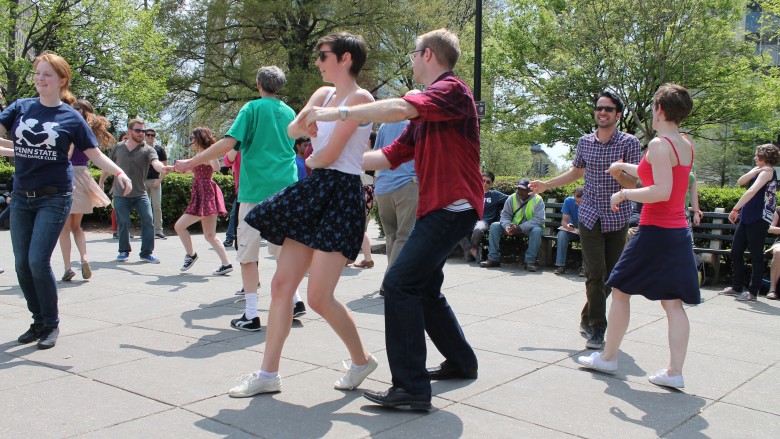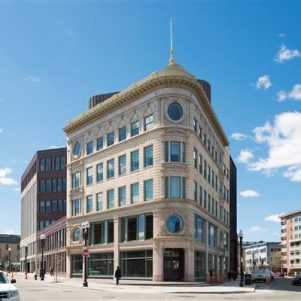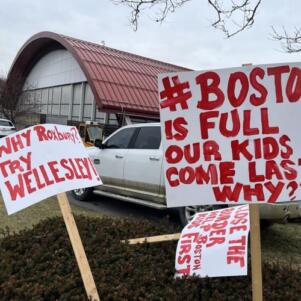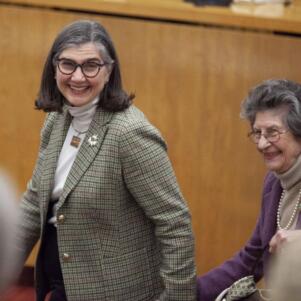Swing dancing climbs in popularity among Hub newcomers
By Lizzie Short | February 23, 2016, 5:00 EST
 Dancers do the Lindy Hop on a sunny day. (Photo courtesy of Wikipedia.org)
Dancers do the Lindy Hop on a sunny day. (Photo courtesy of Wikipedia.org) BOSTON – More than 100 colleges and universities call the Hub home and while many students and young professionals spend time learning to Dougie or whip and nae nae in dance clubs, others find friends and have fun in the area’s vibrant swing-dancing community.
The traditional dance form dating back to the early 20th century can be an eye-opener for newcomers unfamiliar with the culture.
“When I came to live in the United States I was at a rave and, among all the tecktonik, grinding and glowsticking, I saw two people dancing together, hand-in-hand, structurally, side-to-side – a partnership,” Edgard Hernandez Reyna said Friday in an email. “When the song was over, I approached them and they told me it was called swing.”
Luckily for Reyna, now a swing dancer himself, Boston has a number of venues, studios, dances and student clubs that cater to enthusiasts, offering everything from free dances and lessons for beginners to dancing with live bands and competition opportunities. Dancers say it can be a great way to meet new people, particularly for those newly arrived in the area.
“I’ve made a good many friends through swing dancing,” Andrea Byrnes, who moved to the Hub to do post-graduate work at Massachusetts General Hospital in Boston, said by email Monday. “It’s fun to do a very vintage, American dance with people from all over the world, but also chat with these same people who have exciting lives outside dancing – there are doctors, engineers, artists, musicians, diplomats, students, teachers, researchers, etc. It’s a really fun and interesting group.”
Edgar B. Herwick III, now a teacher and organizer at the Boston Lindy Hop dance studio, began taking swing classes when he moved to the area nine years ago.
“I was looking for ways to meet people, so I went to classes,” he said. “I always liked the music, swing music, and I had a background in musicals, dancing and theater.”
Herwick focused on the Lindy Hop and now offers classes in Harvard Square and near North Station in Boston.
Lindy Hop is a particular kind of swing dancing, named for Charles Lindbergh, whose groundbreaking transatlantic flight in 1927 made him famous. During Lindbergh’s solo flight, or “hop,” from New York to Paris, a swing dancer quipped to a reporter that his dance was called the Lindy Hop. The name stuck.
“We call it a social dance for a reason: Lindy Hop in its essence is a social dance,” Herwick said. “We go out after class and get a beer or a soda or fries or whatever – we try to hang out.”
For Reyna, swing offers a way to communicate beyond words. “The social aspect of swing dancing is the communication that goes on when dancing,” he said. “For the duration of the song, you get to know so much about the person you dance with and say a lot about yourself.”
“This has felt great for me, coming from another country and having a different native language. I know how to make conversations about the weather, but that’s not what I want to say,” Reyna said. “That’s why I like the connection and communication in swing dancing.”
At the Massachusetts Institute of Technology’s Lindy Hop Society, socializing is fundamental. The group holds free dances on Wednesday nights, the only free swing dance in the Boston area. MIT student groups are allowed to rent campus space for free, while DJs and instructors volunteer their time, according to Ken Takusagawa, an alumni organizer for the society.
“Dances are open to anyone, and we get a lot of students from nearby colleges, as well as recent graduates,” Takusagawa said. He participated as an MIT student before graduating 10 years ago.
As the only free dance open to the public in the area, the society’s Wednesday night sessions attract a lot of beginners looking to see what it’s like before spending money on lessons or other dances.
People “show up with little or no dance experience, maybe they take the lesson before the dance,” Takusagawa said.
The social focus and welcoming atmosphere makes beginners feel comfortable at most swing events, according to Cassie Filios, who regularly takes to the dance floor these days.
“I was always reassured that it was okay for me to be there,” Filios said by telephone on Thursday, speaking about swing dances she attended as she was learning. “It’s very welcoming to beginners and new people, like, ‘Oh, it’s cool if I just hand out and try this out.”
Swing City in Boston hosts a dance every other Saturday with a live band and lessons.
“We offer a beginner class every week – sometimes we have upwards of 50 people in that class,” said Olaf Beck, Swing City’s co-director. “Lots of regulars who come have been dancing for years and come every week.”
McKenzie Kramer, who began swing dancing about 10 years ago, recently moved to Boston from Oregon and found the city’s scene conducive to developing her social life.
“Actually, it was interesting, being asked out on a date after the first dance that I went to here in Boston, because I find that in everyday life dates don’t come easily at least for me, for some reason,” Kramer said. “I think the dance-setting provided an easy way to connect with someone.”
“One of my favorite things about swing dancing is the physical connection you can have with someone can completely take form on its own and you can communicate something without any words,” Kramer said, echoing Reynes and Salvatori. When she began swing dancing, she said, “it was always a blast – no matter whatever sort of mood I was in, it would always cheer me,” she said. “It was an instant up, instant happy.”
Swing’s popularity appears to be on the rise among younger people, according to event organizers and instructors, including Beck and Herwick.
“College students come to our dances and take our classes,” Herwick said. “We get a lot of people in their 20s and 30s, young professionals, grad students.”
Some of the rise may stem from a resurgence in movies and shows focusing on the Jazz Age, such as the “Boardwalk Empire” television series and a recent film version of F. Scott Fitzgerald’s classic, “The Great Gatsby,” Herwick surmised.
“All these things bring the time period back into peoples’ consciousness,” he said.
Another sign of increasing popularity of the form can be seen in the crowds who flock to the MIT society’s Wednesday night dances, Takusagawa said.
“The MIT program gets to use facilities for free, and we get a ton of people,” he said. “We’re almost hitting the limit of the number of people we can host.”
Herwick speculates that swing provides a way for people to interact with relative strangers in a way that isn’t intermediated by technology. Kramer says the activity can be a real ice breaker.
“I think the dance-setting provided an easy way to connect with someone,” she said, adding that it lets dancers “be at ease and see if that could turn into more of a real connection outside of the dancing.”











